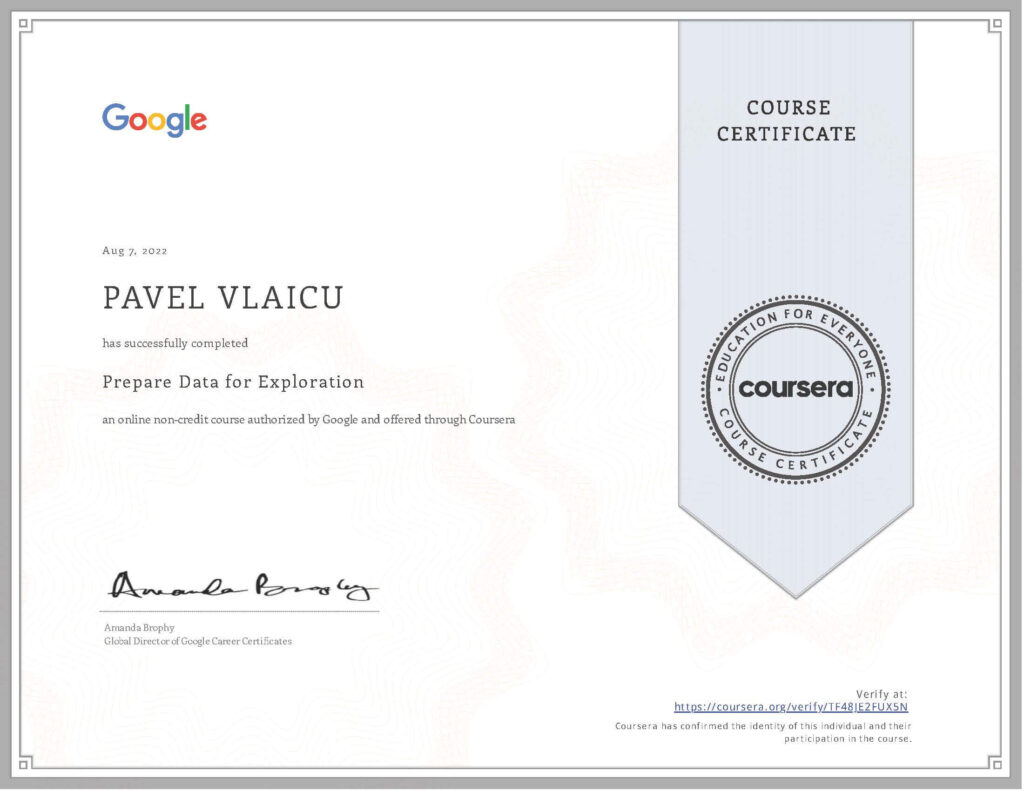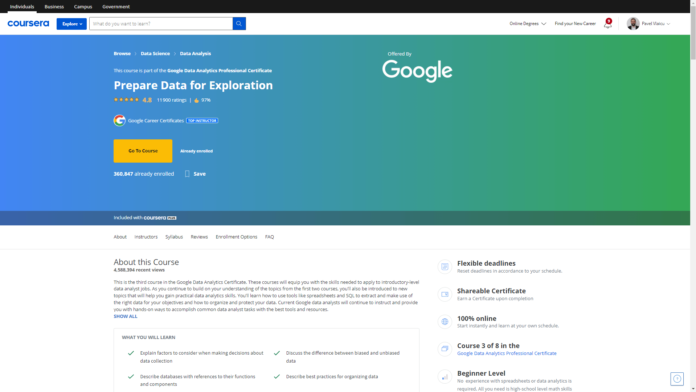About this Course
This is the third course in the Google Data Analytics Certificate. These courses will equip you with the skills needed to apply to introductory-level data analyst jobs. As you continue to build on your understanding of the topics from the first two courses, you’ll also be introduced to new topics that will help you gain practical data analytics skills. You’ll learn how to use tools like spreadsheets and SQL to extract and make use of the right data for your objectives and how to organize and protect your data. Current Google data analysts will continue to instruct and provide you with hands-on ways to accomplish common data analyst tasks with the best tools and resources.
Learners who complete this certificate program will be equipped to apply for introductory-level jobs as data analysts. No previous experience is necessary.
By the end of this course, you will:
– Find out how analysts decide which data to collect for analysis.
– Learn about structured and unstructured data, data types, and data formats.
– Discover how to identify different types of bias in data to help ensure data credibility.
– Explore how analysts use spreadsheets and SQL with databases and data sets.
– Examine open data and the relationship between and importance of data ethics and data privacy.
– Gain an understanding of how to access databases and extract, filter, and sort the data they contain.
– Learn the best practices for organizing data and keeping it secure.
What you will learn
Explain factors to consider when making decisions about data collection
Discuss the difference between biased and unbiased data
Describe databases with references to their functions and components
Describe best practices for organizing data
Skills you will gain
Spreadsheet
Metadata
Data Collection
Data Ethics
SQL
Instructor
Google Career Certificates
Offered by
Google Career Certificates are part of Grow with Google, an initiative that draws on Google’s 20-year history of building products, platforms, and services that help people and businesses grow. Through programs like these, we aim to help everyone– those who make up the workforce of today and the students who will drive the workforce of tomorrow – access the best of Google’s training and tools to grow their skills, careers, and businesses.
Syllabus – What you will learn from this course
Week 1
Data types and structures
We all generate lots of data in our daily lives. In this part of the course, you’ll check out how we generate data and how analysts decide which data to collect for analysis. You’ll also learn about structured and unstructured data, data types, and data formats as you start thinking about how to prepare your data for exploration.
Week 2
Bias, credibility, privacy, ethics, and access
When data analysts work with data, they always check that the data is unbiased and credible. In this part of the course, you’ll learn how to identify different types of bias in data and how to ensure credibility in your data. You’ll also explore open data and the relationship between and importance of data ethics and data privacy.
Week 3
Databases: Where data lives
When you’re analyzing data, you’ll access much of the data from a database. It’s where data lives. In this part of the course, you’ll learn all about databases, including how to access them and extract, filter, and sort the data they contain. You’ll also check out metadata to discover the different types and how analysts use them.
Week 4
Organizing and protecting your data
Good organization skills are a big part of most types of work, and data analytics is no different. In this part of the course, you’ll learn the best practices for organizing data and keeping it secure. You’ll also learn how analysts use file naming conventions to help them keep their work organized.
Week 5
Optional: Engaging in the data community
Having a strong online presence can be a big help for job seekers of all kinds. In this part of the course, you’ll explore how to manage your online presence. You’ll also discover the benefits of networking with other data analytics professionals.
*Course challenge*
Prepare for the course challenge by reviewing terms and definitions in the glossary. Then, demonstrate your knowledge of data collection, ethics and privacy, and bias during the quiz. You will also have an opportunity to apply your skill with spreadsheet and SQL functions, as well as filtering and sorting. Finally, secure and organize data with data analytics best practices.
About the Google Data Analytics Professional Certificate
Prepare for a new career in the high-growth field of data analytics, no experience or degree required. Get professional training designed by Google and have the opportunity to connect with top employers. There are 380,000 U.S. job openings in data analytics with a $74,000 median entry-level salary.
Data analytics is the collection, transformation, and organization of data in order to draw conclusions, make predictions, and drive informed decision making. Over 8 courses, gain in-demand skills that prepare you for an entry-level job. You’ll learn from Google employees whose foundations in data analytics served as launchpads for their own careers. At under 10 hours per week, you can complete the certificate in less than 6 months. You’ll prepare yourself for jobs that include junior or associate data analyst, database administrator, and more. Upon completion of the certificate, you can directly apply for jobs with Google and over 150 U.S. employers, including Walmart, Best Buy, Astreya. 75% of Google Career Certificate Graduates in the United States report an improvement in their career trajectory (e.g. new job or career, promotion or raise) within 6 months of certificate completion US Burning Glass Labor Insight Report salary data (median with 0-5 years experience) and job opening data. Data for job roles relevant to featured programs (4/01/2021 – 3/31/22). Based on program graduate survey responses, United States 2021

